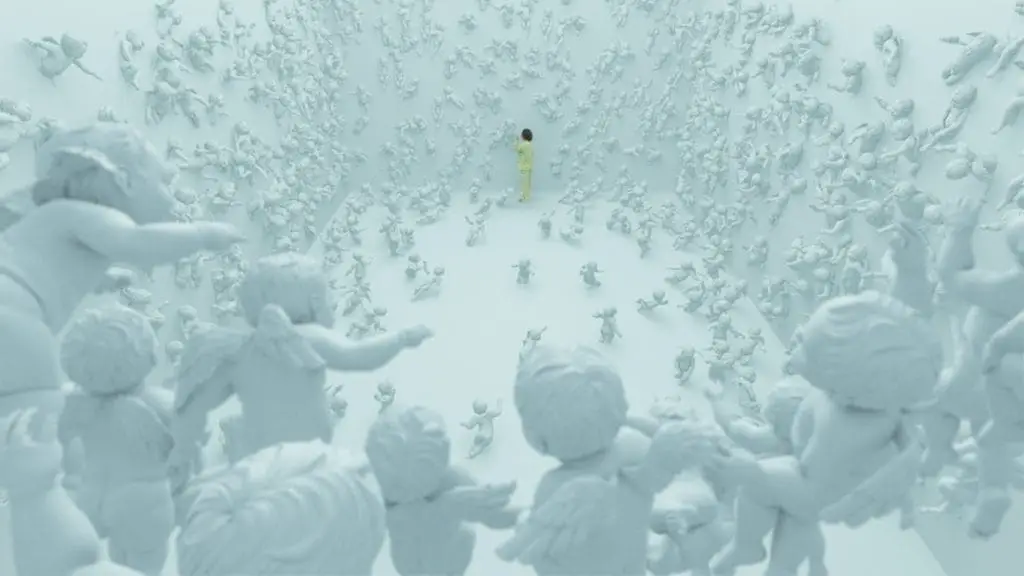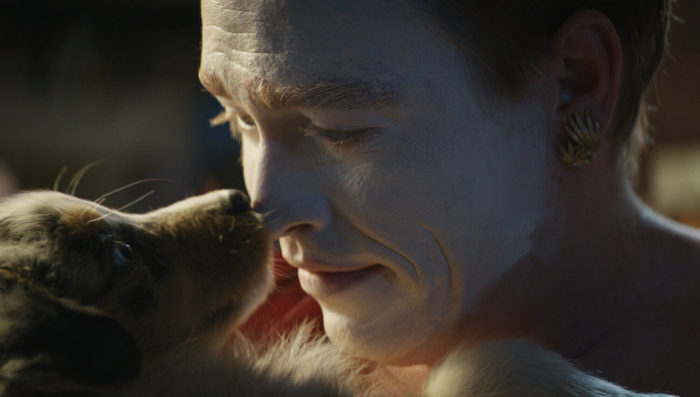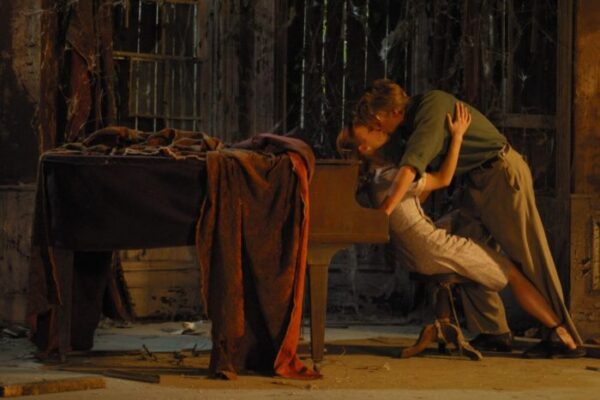The Meaning Of The Movie Symbol (2009), Plot Summary, Explanation Of The Ending. Cupids, Cataclysms & Phalluses: Analysis of the Art-house Comedy “Symbol”.
Country: Japan
Genre: Art House, Comedy, Fantasy
Year of Production: 2009
Director: Hitoshi Matsumoto
Cast: Hitoshi Matsumoto, David Quiterro, Luis Accinelli, Lilian Tapia
Awards and Nominations: 2010 Asian Film Awards (Best Actor, Best Special Effects)
The meaning of the film “Symbol” (Shinboru), the brainchild of the famous Japanese comedian Hitoshi Matsumoto, will definitely not be able to decipher. Such are many works in the art house genre: what is valuable here, first of all, are the ways in which the director immerses you in his world, and what topics he raises. Finding the only clue in them is difficult, and sometimes there is no need.
What is the movie about
In the remote Mexican countryside, a wrestler known as the Snail Man faces a crucial fight for the championship belt. His opponent, young and daring, presents a formidable challenge. As the fight approaches, we witness the fighter’s family dynamics, including a visit from his father-in-law and son, who come to support him.
Meanwhile, another storyline unfolds, featuring a Japanese man dressed in colorful pajamas. This mysterious figure, whose identity remains unknown, finds himself trapped in a room with white walls, devoid of doors or windows. He soon discovers an angelic figure’s protruding “genital-switch,” which allows him to interact with the space, activating objects and opening doors. As he navigates through a series of rooms, his surroundings change, offering him a series of increasingly bizarre and puzzling encounters.

The hero in bright pajamas, played by Hitoshi Matsumoto. Frame from the film.
The Snail Man’s fight intensifies, and as he nears defeat, the pajama-wearing hero’s actions in his otherworldly space unexpectedly turn the tide. By pressing the “switch,” the Snail Man’s fight reverses in his favor. The surreal journey continues, with additional scenes involving a band in Los Angeles, Russian television, and more strange interactions with the pajama man’s environment, affecting the human world with each action.
In the film’s climax, the pajama-clad protagonist ascends into a spiritual realm, witnessing the unfolding of significant human events — wars, natural disasters, and achievements — all influenced by his actions. In the end, he reaches a divine-like state, symbolized by his ascension and the eventual realization of his impact on the world.

Frame from the film.
Director Hitoshi Matsumoto expertly misleads the audience, creating a story that resists clear interpretation. The two main plotlines — the Snail Man’s fight and the pajama-wearing man’s surreal journey — appear disconnected at first, but they are linked through the theme of human influence on the world. As the pajama-clad figure learns to control his surroundings, he ultimately embodies humanity’s progress and its sometimes reckless consequences.
The film’s structure, divided into “Study,” “Application,” and “Future,” mirrors the stages of human development, from ignorant experimentation to the recognition of the broader impact of one’s actions. The protagonist’s eventual wisdom, symbolized by his transformation, reflects the journey from childlike capriciousness to maturity and responsibility.
Additionally, Symbol carries religious undertones. The Snail Man’s family, especially his daughter (a nun) and his son (whose faith in his father leads to tragic consequences), subtly evoke Christian themes. The pajama-wearing figure’s actions, resembling a child god learning through trial and error, suggest a critique of traditional religious narratives about a wise, omnipotent god.
Ultimately, Symbol explores existential questions, hinting that even higher powers, like the protagonist, may be trying to understand their purpose and the true nature of their influence.
The meaning of the film Symbol
The director of Symbol skillfully manipulates audience expectations, deceiving us from the very beginning. We’re quickly drawn into trying to understand the strange circumstances surrounding the man in pajamas. However, analyzing the details reveals little—his bizarre adventures in the white room seem more like a prank than a serious narrative. Attempts to connect the two storylines fail to reveal any meaningful correlation, as the “Mexican story” lacks depth or hidden significance. It becomes clear that the man in pajamas, through a simple “switch,” can influence various events on Earth, but the larger purpose remains elusive.

Frame from the film.
As the film progresses, we begin to uncover meaning, especially in the story of the man in pajamas. Despite the director’s playful mockery of both the characters and the audience, there is an underlying significance to the story. The division of the film into chapters—”Study,” “Application,” and “Future”—suggests a deliberate structure.
One interpretation is that the man in pajamas represents mankind. In the “Study” phase, his actions mirror those of a primitive being, exploring the world through trial and error—crying, complaining, and praying. He eventually discovers a way to make a dramatic leap forward. In the “Application” phase, burdened by progress, he gains remarkable power but remains unaware of the consequences of his actions. Only in the “Future” phase does he acquire wisdom, symbolized by changes in his clothing and appearance.
This interpretation aligns with the idea of human evolution, but Symbol also includes religious subtext. The Snail Man’s storyline hints at this, with his daughter being a nun and scenes featuring Christian imagery like crosses and icons. His son’s blind faith in his father contrasts with the boy’s suffering from his father’s powerful blow—an event caused by the man in pajamas, who acts without understanding the consequences of his actions.
In many ways, the man in pajamas reflects a childlike deity—one who only acquires wisdom with time. Before reaching this wisdom, his behavior is capricious and erratic. This interpretation challenges traditional religious views, where God is portrayed as wise and loving. Instead, Symbol suggests that the divine may also be on a journey of self-discovery, trying to understand not only who they are but also the desires of the angels around them.
Symbol Ending explanation
The ending of Symbol leaves viewers with more questions than answers. The man in pajamas, having gained wisdom and understanding through his journey, faces a choice: press the final “switch” and risk altering the course of history once again. The global implications of his decision are hinted at but never fully explained. This ambiguity suggests that his actions, while powerful, are ultimately beyond his comprehension.
Matsumoto’s closing sequence, with the man flying toward an uncertain future, serves as a reminder of humanity’s struggle for knowledge and understanding. The film ends on a note of dark humor, inviting audiences to reflect on the absurdity of our existence. Symbol is not just about the journey of one man but about the folly and grandeur of humanity as a whole—our attempts to understand the world, our power, and the consequences of our actions.
Matsumoto plays with the audience’s expectations, leading viewers to seek a coherent explanation that never fully materializes. The juxtaposition of the two plotlines—the Snail Man’s struggle in the ring and the pajamas-clad man’s surreal journey—becomes central to the film’s underlying theme: the unpredictable and often absurd consequences of human actions.
As the film progresses, there is a hint that the man in pajamas represents humanity itself, exploring the world through trial and error, unaware of the broader consequences of his actions. At the “learning” stage, he behaves like a child, testing boundaries and trying to understand his power. Over time, however, he matures, realizing the enormity of his influence, symbolized by the changes in his appearance and demeanor.
Religious undertones emerge as the Snail Man’s storyline hints at divine symbolism, particularly in the relationship between the characters and the faith placed in them. The film also critiques the idea of a wise, all-knowing god, suggesting that even divine figures might be fumbling through existence in a quest for understanding.







